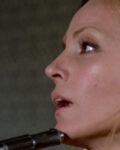Lalo Schifrin’s Che!
 Twilight Time’s release of Che! (1969) gives me an excuse to add some favourite supporting materials towards a biopic that’s been written off as kitschy and absurd for casting Omar Sharif as doomed revolutionary Che Guevara, Fidel Castro’s right hand man during the Cuban Revolution, and Jack Palance as Castro, putty nose and all.
Twilight Time’s release of Che! (1969) gives me an excuse to add some favourite supporting materials towards a biopic that’s been written off as kitschy and absurd for casting Omar Sharif as doomed revolutionary Che Guevara, Fidel Castro’s right hand man during the Cuban Revolution, and Jack Palance as Castro, putty nose and all.
Che! isn’t that bad – in fact, it’s not really awful at all – but it suffers from a certain cheapness that might be due to its annoying structure than modest budget, but what’s always transcended the film is Lalo Schifrin’s score. Those familiar with the old Tetragrammaton and AEI LPs know what I’m talking about – a huge array of exotic percussion, and great Latin rhythms anchored to a marvelous main theme.
The surprise is how the LP differs from the film – the LP cuts are mostly rerecorded versions – but that doesn’t belittle the music used in the film which comes back to Schifrin’s central theme, and provides needed empathy for a character who’s intriguing during the Cuban campaign, but ultimately dull in the film’s second half, wandering through the mountains of Bolivia trying to recruit new revolutionaries. Guevara gets more frustrated, more tired, his asthma gets worse, and then he dies – shockingly dull denouement to a charismatic historical figure that became a pop culture icon because “Guerrillero Heroico,” that magnetic photo taken by Alberto Korda.
Alongside a review of Che! is a comparative review of the original LP and Schifrin’s reissue CD (available from Aleph Records) with significantly different content. It’s one of my favourite Schifrin albums because it’s so rich in rhythms, and there’s always new details one discovers when revisiting the music. It’s also flawlessly orchestrated; the jazz solos within some cues fit so seamlessly within a cue’s firm structure, and the only downside is the rerecorded cues don’t run longer into something as epic and intense as his jazz albums. That said, I think “Charangos” and “La Ruta” are among the best things he’s ever written; if the cues ran ten times longer, I’d be in Heaven.
Schifrin may be deservedly known as a great jazz pianist, composer, and blender of urban styles in scores like Dirty Harry (a genuine work of art), but he’s also a sublime orchestrator. One of the related reviews I’ve added is a 3-episode compilation of Jazz Casual, Ralph Gleason’s irregular NET series that featured jazz greats in a low-key studio, talking a little about their art, but mostly playing examples of the music they love. It’s a series screaming for a reissue – Rhino handled the last VHS and DVD release years ago – and between the episodes with Count Basie and John Coltrane is the Dizzy Gillespie Quintet, with a young Schifrin performing an extract from his Gillespiana.
I’ve a taste for polyphonic rhythms, minimalism, and brass, and certainly in the rhythm department, Schifrin is a master. It’s not about piling on textures and being loud, but being selective, fitting an instrumental palette with the needs of characters and a film as a whole, and knowing when to apply music and when silence and sound design can function as part of an overall ‘score.’
Schifrin’s career goes back to the late fifties in his beloved Argentina, and his career has spanned all kinds of media, genres, and music idioms. He’s an elder statesman of modern jazz, and a pivotal ambassador of Latin rhythms. In that Gillespiana extract, you watch him hammer out a complex rhythm that circles, shifts, resets, and spirals again with mad energy, but there’s that calm concentration of an artist and a professional at work and play.
His work in the concert arena was captured in the documentary Movie Music Man: A Portrait of Lalo Schifrin, filmed in 1993 and released on DVD in 2001 by Image, and reissued in 2011 by Kultur. It’s a good doc with decent concert extracts, but like most of these films, you wish there was more, if not the option to watch the entire concert.
Coming soon: a review of Scent of Mystery, aka Holiday in Spain, the first and last film in Smell-O-Vision, newly released on Blu-ray by Redwind Productions, and restored by Dave Strohmaier as part of his ongoing mandate to rescue Cinerama films from oblivion. Tied to the review will be several interviews, and a podcast with Strohmaier who discusses reconstructing the film from surviving elements.
Cheers,
Mark R. Hasan, Editor
KQEK.com
Category: EDITOR'S BLOG

















Connect